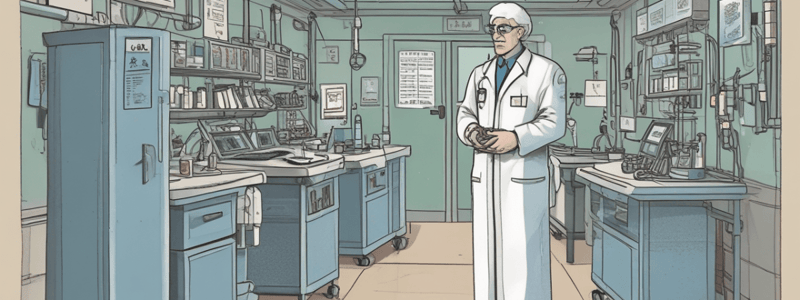Podcast
Questions and Answers
What percentage of septic shock patients had muscle weakness at hospital discharge?
What percentage of septic shock patients had muscle weakness at hospital discharge?
- 55%
- 45%
- 79% (correct)
- 25%
What is the percentage of control patients with acute disease requiring hospitalization who had not recovered their pre-illness autonomy at 6 months?
What is the percentage of control patients with acute disease requiring hospitalization who had not recovered their pre-illness autonomy at 6 months?
- 15% (correct)
- 30%
- 25%
- 20%
What is the mean physical quality-of-life score (PCS) assessed by the MOS SF-36 in control patients at 6 months?
What is the mean physical quality-of-life score (PCS) assessed by the MOS SF-36 in control patients at 6 months?
- 49±2
- 51±4 (correct)
- 45±5
- 48±3
What is the only variable predictive of a poor outcome in septic shock patients at 6 months?
What is the only variable predictive of a poor outcome in septic shock patients at 6 months?
What is the main cause of lymphedema in patients with septic shock?
What is the main cause of lymphedema in patients with septic shock?
What percentage of patients with septic shock admitted for more than one week develop ICU-acquired weakness and myopathy?
What percentage of patients with septic shock admitted for more than one week develop ICU-acquired weakness and myopathy?
What is the percentage of septic shock patients who have persistent muscular dysfunction at 6 months?
What is the percentage of septic shock patients who have persistent muscular dysfunction at 6 months?
What is a potential long-term consequence of septic shock?
What is a potential long-term consequence of septic shock?
Flashcards are hidden until you start studying
Study Notes
Septic Shock Outcomes
- 79% of septic shock patients experience muscle weakness at hospital discharge.
- At 6 months, 28% of septic shock patients have not recovered their pre-illness autonomy, compared to 15% of controls with acute disease requiring hospitalization.
Quality of Life
- At 6 months, the mean physical quality-of-life score (PCS) assessed by the MOS SF-36 is 48±3 in septic shock patients, compared to 45±5 in ARDS patients and 51±4 in control patients (P=0.009).
Predictors of Poor Outcome
- Self-professed loss of autonomy is the only variable predictive of a poor outcome, with a diagnostic odds ratio of 3.90, 95% CI 1.18–12.83, area under the ROC curve 0.68, 95% CI 0.53–0.83.
Long-term Consequences of Sepsis
- Septic shock has significant long-term consequences, including long-term cognitive impairment, ICU-acquired weakness and myopathy, and considerable pain.
- The incidence of ICU-acquired weakness and myopathy ranges from 25% to 55% of patients with septic shock admitted for more than one week.
- About 25% of patients experience persistent muscular dysfunction.
- Other potential long-term effects of septic shock include drowsiness, anxiety, depression, and symptoms of post-traumatic stress.
- Patients can also develop lymphedema through infections such as acute lymphangitis, often caused by repeated episodes of cellulitis.
Studying That Suits You
Use AI to generate personalized quizzes and flashcards to suit your learning preferences.




